Thermal Efficiency in
Georgian and Regency Houses
We regularly carry out surveys on older properties
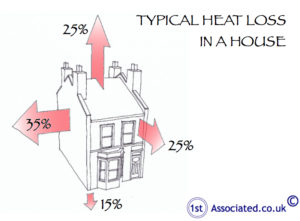 We are Independent Surveyors who regularly carry out Independent Building Surveys sometimes known as Structural Surveys. We have Surveyors who specialise in older properties and can also help with regard to independent valuations, engineer's reports and specific defects reports with regard to things such as dampness and woodworm. Please free phone 0800 298 5424 for a friendly chat with one of our surveyors.
We are Independent Surveyors who regularly carry out Independent Building Surveys sometimes known as Structural Surveys. We have Surveyors who specialise in older properties and can also help with regard to independent valuations, engineer's reports and specific defects reports with regard to things such as dampness and woodworm. Please free phone 0800 298 5424 for a friendly chat with one of our surveyors.
Over the years we have seen people become more and more interested with how thermally efficient their Georgian and Regency properties are. We very much believe that, to some extent, extra insulation and thermal efficiency can be a double edged sword if you do not understand what you are doing to your house.
This is just a reminder about our Free phone number 0800 298 5424. Please feel free to phone for a friendly chat.
 Free phone 0800 298 5424
Free phone 0800 298 5424
Thermal problems in Georgian properties
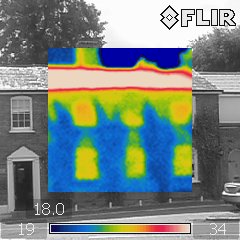
The following article advises about thermal problems and issues that you may have with Georgian or Regency properties. We have also written articles on other eras of housing. So if this is not the era of the house that you live in then please have a look at our other articles as we are sure to have carried one that applies to you.
What do Georgian and Regency properties look like?
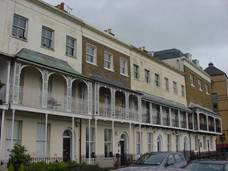
Georgian and Regency properties date from approximately 1715-1830. However remember that eras do not strictly follow a definite deadline and builders would not have stopped building in one style and started building in another style on those exact dates. Some will have features from different eras running into other eras.
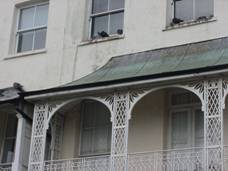
The typical Georgian or Regency property tends to be a square shaped building. They will also often have hidden roofs and hidden gutters to the front together with large windows as natural light was so important in days gone by.
The feature that differentiates Georgian properties from Regency properties is the use of iron work.
Thermal efficiency of Georgian and Regency houses and homes
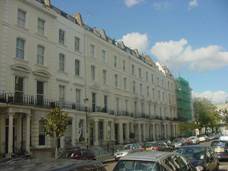
Remember these houses were built between 1715 and 1830 and as such the concept of energy efficiency did not exist. In fact it is not until very recently in the 1970's when the oil and fuel crisis made us look at thermal efficiency and think twice about how we use fuel. This resulted in us putting insulation in our existing housing stock and commercial buildings. More recently we are building properties much more energy efficiently.
What were the Victorians and Edwardians thinking about when they built their houses?
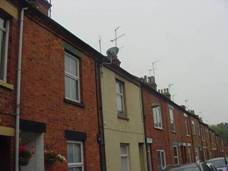
When houses were built in the Victorian and Edwardian eras little thought was given to thermal efficiency. The rooms were heated with both coal fires and wood fires and there would literally have been a fire in almost every room. A very common feature of Victorian properties is access to a coal storage area either via gates to the back of the property that give access to a coal shed or via coal chutes to the front of some properties.
A good gauge of this increased thermal efficiency is that in the 1970's we had an insulation level of 0 - 50mm in the roof space and in the present day we insulate using over six times that level in the roof space.
What makes a Georgian or Regency house different to a modern house?
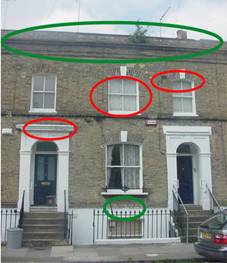
If you compare an older property and a newer property they both have the same basic elements such as roofs, walls, windows, doors etc. However, the performance of the two from a thermal point of view is very different. The main difference is the modern house is built considering the thermal efficiency.
Technology wise the Georgian and Regency properties were built in an era when heating the house was via a coal fire.
Let's start at the top of the property and work down.
Roofs
Butterfly roofs on Georgian and Regency properties would originally not have been insulated but we now coming across roofs that have been insulated. The problem caused by doing this, without considering ventilation for the roof, is that condensation is occurring causing mould on the timbers. Whilst it is important to insulate it is also important to ventilate as well.
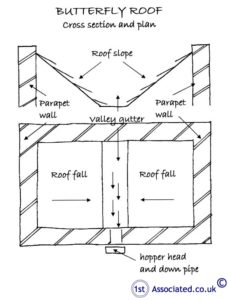 |
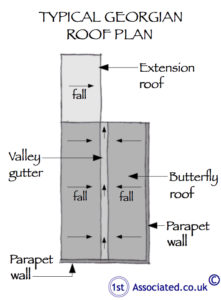 |
|
|
Typical Georgian roof plan
|
Walls
An older Georgian or Regency property will have a solid wall with a Flemish or English bond construction. These solid walls have poor thermal efficiency compared with a modern insulated dry-lined wall. However we would argue that they do have benefits as once a mass wall is warmed up by the environment it then gives the heat back unlike a modern property that reflects the heat.
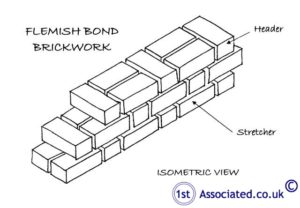 |
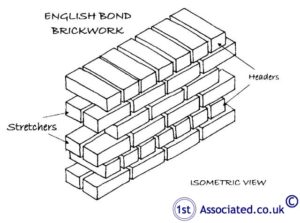 |
|
Flemish Bond
|
English Bond
|
Windows
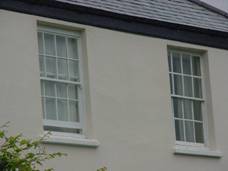
An original Georgian or Regency building would have sliding sash windows. These would have been single glazed and made in a variety of styles which would have been influenced by the need to improve the performance of the window from a movement point of view and to make them safer from a fire point of view. They certainly will not be double glazed and at best they may be secondary glazed.
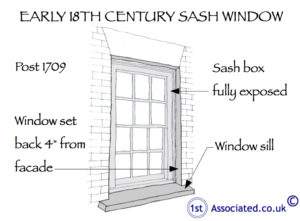 |
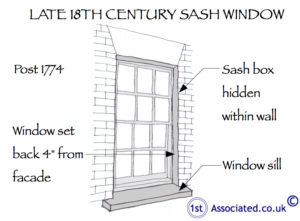 |
|
|
Later Georgian sash window
|
Windows

An original Georgian or Regency building would have sliding sash windows. These would have been single glazed and made in a variety of styles which would have been influenced by the need to improve the performance of the window from a movement point of view and to make them safer from a fire point of view. They certainly will not be double glazed and at best they may be secondary glazed.
Floors

A traditional floor in a Georgian or regency property would be a suspended timber floor which allows for airflow underneath it. This ventilation is also needed to prevent wet rot, dry rot and woodworm.
However, in a modern house there is likely to be a solid floor usually with insulation
A modernised Georgian or Regency house
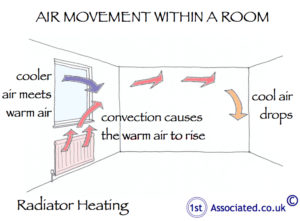
A modernised Georgian or Regency house is a mixture of the original construction with newer elements such as insulation in the roof and radiators (which we forgot to mention above). Radiators are very important as they need to be positioned under windows to allow airflow in the rooms.
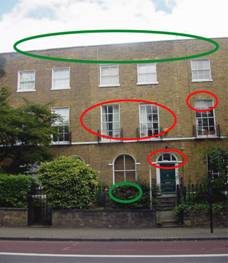
The adjacent photograph shows a Georgian property and we have used our system of red and green ovals and circles to highlight areas of original (red) and newer elements (green) in the property.
The Red ovals show:
1. Lintels over the door and windows
2. Sliding sash single glazed windows
The Green ovals show:
1. The top green oval is the modern roof insulation.
2. The lower green oval is where a radiator would be under the window in the property.
Here are some other articles that may be of interest to you:
Damp and condensation problems with houses built from the 1930's to 1950's
Energy efficiency, have we got it all wrong?
Compare Surveys
Things you cannot do much about, such as thermal bridging, cold bridging and condensation, or can you?
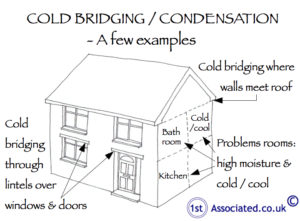
Many people think that an older property must have to be cold which is not necessarily true. However, an older property will have colder elements which come from the way it has been constructed.
For example the large windows on Georgian properties will be a thermal bridge area and humidity in the air will cause condensation on the windows.
This sketch gives a good indication of where humidity originates from in a building and the cold bridging elements through which thermal and cold bridging is caused.
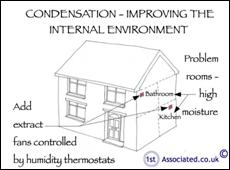
Humidity in residential properties can be caused by such things as:
1. Showering
2. Bathing
3. Cooking
4. Washing and drying clothes, particularly if you are drying washing on the radiators inside.
Our answer to the question above is to ensure that the property has large humidity controlled extract fans. This will need to be carried out sympathetically regarding the age of the building and you may even need to have Listed Buildings or Conservation Area permission.
Extensions and alterations can also affect Georgian and Regency properties
The main issue that we come across with properties that have a mixture of different ages and eras of construction is that the colder original section tends to suffer more from condensation and is often wrongly diagnosed as rising damp.
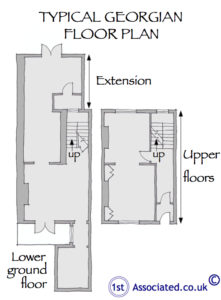
Here we start to have a mixture of different styles and ages in a property. We have the original features mentioned above from the Georgian and Regency era and now in addition to this there may be a 1960's extension, which will have a fairly low thermal efficiency or possibly an extension from the 1970's,1980's etc.
We have even come across properties that have been treated for rising damp quite frequently.
So if you suspect you may have rising damp or even if a damp proofing specialist company (which usually sell nothing apart from rising damp liquid) say you have rising damp please phone us on 0800 298 5424 and we will happily come out and carry out an Independent Building Survey which could save you thousands of pounds.
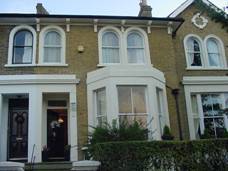 |
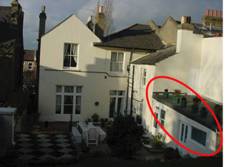 |
|
Front view of a late Georgian propety with rear extension |
Rear view of a late Georgian propety with extensions
|
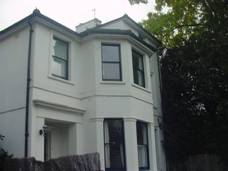 |
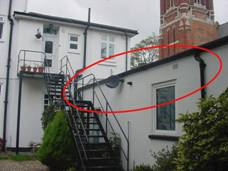 |
|
Georgian property converted into flats
|
Converted Georgian flats extended to the rear
|
Surveyors with thermal imaging cameras?
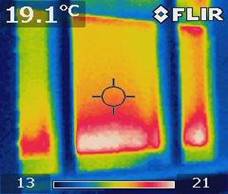
Yes we do have thermal imagers and yes it can be dangerous for Surveyors using thermal imagers if they do not have enough experience working with them. We have developed knowledge of thermal imaging cameras over the many years we have now worked with them. We have even given lectures about them at universities.
Heating in Georgian and Regency properties
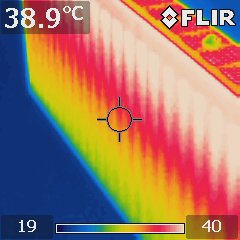
Most properties today, we find, have a boiler and a water heated radiator system. These can be of various ages and the efficiency of the boiler being the key factor.
We are not sure whether the modern boilers are more cost effective as having spoken to maintenance people over the years we are generally finding that modern boilers do not last as long and require more maintenance. This is not a scientific study! It is just comments that we have heard.
A few questions on the thermal properties of Georgian and Regency properties
1. Why are Georgian and Regency properties typically so cold?
A few thoughts come to mind but without seeing your property specifically we cannot comment further apart from just generally.
One reason could be that radiators are not sized appropriately for the rooms. There are calculations via British Thermal Units which allow accurate calculations but you do need to take into consideration the size of the rooms particularly the room height as they can be higher than a typical room and also the size of the windows within the rooms.
2. Why do we get black mould in our cupboards?
Often this can be due to a lack of ventilation in a property. We have found with Georgian and Regency properties, where the large windows reach the floor, it is often difficult to know where to put a radiator that should be put under the window. This can result in radiators being out on internal walls which means poor air circulation and results in black mould and dampness in the cupboards.
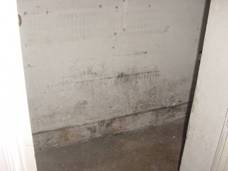 |
 |
|
Black mould on wall of cupboard
|
Black mould
|
3. What is an Expert Witness case?
This is where you employ someone who is a specialist within a field, such as us as Independent Building Surveyors, who comment on problems of condensation within the property. We have been involved in several court cases as expert witnesses where landlords are being taken to court over the condensation that is occurring in their property. The expert witness case looks at how this condensation is occurring and if it relates, for example, to the occupiers' lifestyle or whether it relates to the way the building was constructed and where there are, for example, thermal and cold bridging elements. When discussions of this nature take place in court they can be very expensive.
4. Can an extension cause problems with the building?
Yes in our experience it certainly can. We have come across several cases where no thought or consideration has really been given to how an extension would affect the property from a thermal and condensation point of view.
5. Is your lifestyle a factor in thermal and cold bridging?
This is often a contentious and difficult question, particularly where the occupier is a tenant and there is a disagreement between the landlord and the occupier as to why there is mould in the property. In our experience the major factor is the size of the family living in a property. This is especially the case with large families with young children and where in turn there is a lot of washing of clothes being done. This is particularly the case in the winter months, with the wet washed clothes being dried on radiators. Also general hygiene washing and not to mention cooking to feed everyone all lead toward a more humid atmosphere. This is generally known as the lifestyle of occupants and can be a major factor particularly where there are legal cases as to the problems within a property.
Independent Surveyors
If you truly do want an independent expert opinion from a Surveyor, with regard to independent valuations, mortgages, mortgage companies, building surveys, structural surveys, engineers reports, specific defects reports, structural surveys, home buyers reports or any other property matters please contact 0800 298 5424 and we will call you back.
If you would like to see how our surveys can help you we can supply examples of these. The surveys contain photos, sketches and definitions to help explain the issues that have been found at the property as well as the Executive Summary that highlights the main problems as well as the associated costs.
We hope you found the article of use and if you have any experiences that you feel should be added to this article that would benefit others, or you feel that some of the information that we have put is wrong then please do not hesitate to contact us (we are only human).
The contents of the website are for general information only and are not intended to be relied upon for specific or general decisions. Appropriate independent professional advice should be paid for before making such a decision.
All rights are reserved the contents of the website are not to be reproduced or transmitted in any form in whole or part without the express written permission of www.1stAssociated.co.uk
